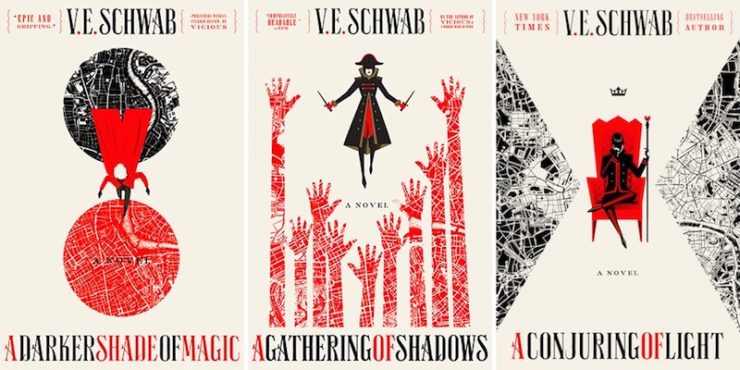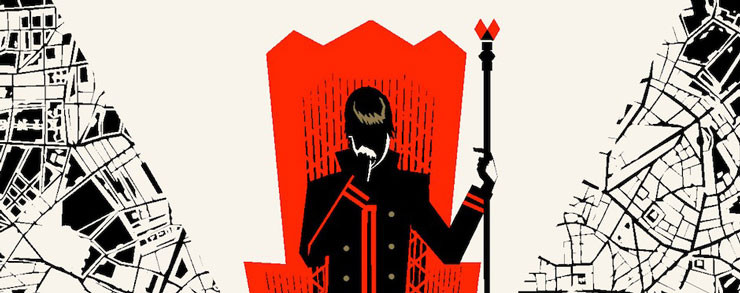With the recent announcement that Sony won a bidding war over movie rights to A Darker Shade of Magic, V.E. Schwab is a name we’re going to hear a lot of in the near future. You may remember her name from back in 2013, when Ridley Scott’s production company acquired the rights to her YA novel, Vicious, or maybe you heard about her in July of 2016, when the film rights to This Savage Song were also acquired by Sony.
But I’m here to tell you that this is NOT the reason why you should be reading her Shades of Magic series. She’s more than just beautiful book covers and flashy movie deals. She’s a writer of real substance—one who is changing the game when it comes to fantasy with her unique take on magic systems, worldbuilding, and most importantly, with her ability to create three dimensional characters we really care about. You should be reading Victoria Schwab RIGHT NOW because she challenges us to examine the grey spaces that exist between traditional definitions of good and evil.
The Shades of Magic trilogy has just recently concluded with A Conjuring of Light. The series follows characters from and through four parallel Londons. After recently listening to her speak at a signing in New York City, I learned that Schwab wanted to build the Londons first and see how their varying relationships with magic affected the people. Grey London, our world, has forgotten magic. White London consumes it to the point of draining the color and joy out of everything, its rulers using fear to control the kingdom. Red London has a balanced relationship with magic, and its users help the city prosper. And Black London is where magic has completely crush out life—it’s a dead world locked away from the other three Londons. The characters that come from these disparate worlds are representative how each world deals with magic.
The magic system here relies completely on elemental magic. It’s reminiscent of Avatar: The Last Airbender for a reason—this series is Schwab’s love-letter to the show. But the worlds that she develops around this elemental magic are rich and incredibly unique. In each world, most people can only control one element’s magic. It’s rarer for someone to be able to control two, or even three more. And rarer still is the one who can control ALL of the elements, including blood magic. In fact, there’s only one in Red London—Kell.
A Darker Shade of Magic introduced readers to Kell, Rhy, Lila, and Holland, and we’ll follow their paths through the next three books. Kell hails from Red London, and though he’s revered as the last Antari, that rare magician who controls all elements of magic, he’s still very much an outsider. Rhy is his brother by adoption, and is also the Prince of the realm. He has no magic whatsoever and maintains a fluid sexuality throughout the series. Lila is a thief from Grey London who has literally bumped into Kell during one of this travels in her world. She also steals a very dangerous magical artifact from him; even though she has no idea that magic even exists, the consequences are very dire for all of them. These three characters illuminate Schwab’s phenomenal worldbuilding because of how they interact with magic and react to magic. Magic builds the worlds, and as she’s said, each world’s attitude towards magic directly shapes what they become. And in turn, each world’s attitude towards magic influences how the most powerful use it.
This is where Holland comes in. Dear, dear Holland. Schwab has mentioned that Holland might be her favorite character she’s written for this series, and I can see why. He’s the only character whose entire story is told in the pages of the trilogy. And he’s a very complex character with complex motivations, playing on the opposite team as Kell, Lila, and Rhy. His villainy illuminates the morality of each character. Holland, one could argue, is amoral, while his foes must battle with what’s right and what’s necessary. It gives him a bit of a Machiavellian advantage on the playing field.
I hesitate to even call Holland a villain, though if we’re going with traditional roles in fiction, I suppose that’s what he is. But really, every villain is the hero of their own story. Holland’s point of view is vividly told, and we see enough of him that the reader can decide for themselves if his intentions are good or not, in spite of his actions. His story is just as real and just as important as Rhy, Kell, and Lila’s stories are, even though they are in opposition most of the time.
This is where we get those shades of grey. White London’s rulers are despicable, but does that mean Holland, who belongs to that world, is too? Kell and Lila break the law—a lot—but to what end? Is rule of law absolute? Should the law be broken for the greater good? And the good Prince Rhy has a lot of envy towards his adopted brother. In A Gathering of Shadows, the two brothers deal with a very literal binding of their lives to each other. Will this suffering create more understanding between the two, or less? When the empathy becomes literal, will it hurt or heal? And should they have to feel each other’s pain to gain this understanding? Could they have come to this understanding without the magical binding?
This is just skimming the surface of the kind of questions Schwab challenges her readers with. And the Shades of Magic series only skims the surface of what Schwab has accomplished (thirteen novels before the age of 30!). Her deep dives into character study also show up in Vicious, a novel with no heroes, as well as in This Savage Song—the first in a duology that portrays crime begetting actual monsters. But who are the real monsters in Schwab’s worlds? I bet they are not always who you think.

V.E. Schwab’s Shades of Magic series—A Darker Shade of Magic, A Gathering of Shadows, and A Conjuring of Light—are available from Tor Books.
Ardi Alspach is a freelance writer and a book publicist in New York City. She hails from sunny South Carolina and can be found on twitter @ardyceelaine.











FYI — there is a YA series called “The Shades of London” so your title is misleading. Or confusing. [Ambiguous, at least.] I can see why you’d feel that was a catchy start to your post.
It IS catchy. 8)
Sorry to jump in as your first comment, but being a fan (of the Shades of London series) made this post grab my attention. Then I got confuzzled. As a copy editor, I’d’ve queried this… I’d suggest “Shades of London Magic” or “Magic — Shades of London” for clarity’s sake.
http://www.maureenjohnsonbooks.com/shades-of-london-series/
Best,
ASZ*—
One theme makes me hesitant to read this series. You said, “she [Victoria Schwab] challenges us to examine the grey spaces that exist between traditional definitions of good and evil.” Does this mean she avoids the fantasy clichés in which dark shades (like black or purple) are used to signify negative or evil, while lighter shades are used to show what is good or pure? If so, I would be interested.